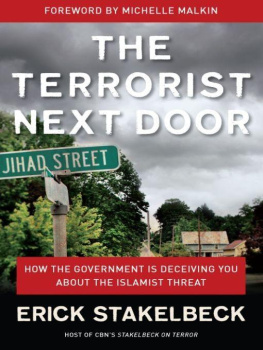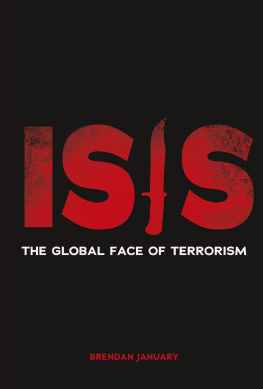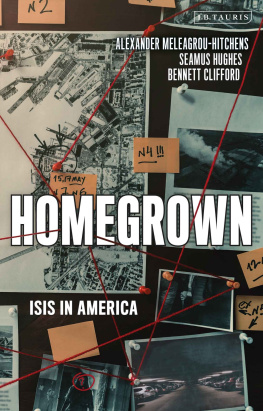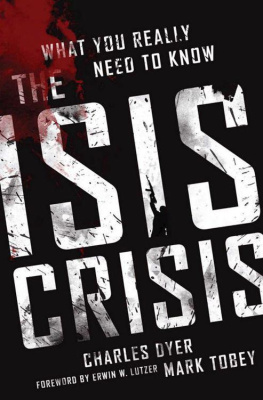


Copyright 2015 by Erick Stakelbeck
All rights reserved. No part of this publication may be reproduced or transmitted in any form or by any means electronic or mechanical, including photocopy, recording, or any information storage and retrieval system now known or to be invented, without permission in writing from the publisher, except by a reviewer who wishes to quote brief passages in connection with a review written for inclusion in a magazine, newspaper, website, or broadcast.
Regnery is a registered trademark of Salem Communications Holding Corporation
First ebook edition 2015
ISBN 978-1-62157-389-0
Library of Congress Cataloging-in-Publication Data
Stakelbeck, Erick.
ISIS Exposed : beheadings, slavery, and the hellish reality of radical Islam / Erick Stakelbeck.
pages cm
1. IS (Organization) 2. Terrorism--Religious aspects--Islam. 3. Security, International. 4. Middle East--Politics and government--1945- I. Title.
HV6431.S687 2015
956.054--dc23
2015003260
Published in the United States by
Regnery Publishing
A Division of Salem Media Group
300 New Jersey Ave NW
Washington, DC 20001
www.Regnery.com
Manufactured in the United States of America
10 9 8 7 6 5 4 3 2 1
Books are available in quantity for promotional or premium use. For information on discounts and terms, please visit our website: www.Regnery.com.
Distributed to the trade by
Perseus Distribution
250 West 57th Street
New York, NY 10107
To my mom, Agnes. Thank you for a lifetime of love, patience, support, and understanding and for teaching me to trust in the Lord.
CONTENTS
WELCOME TO LITTLE MOGADISHU.
I motioned out the car window toward a steady procession of Somali women covered in Islamic garb walking up and down the street, carrying shopping bags.
This must be it, my cameraman, Ian, agreed.
We pulled over to get the lay of the land. Groups of men congregated outside a gritty strip of Somali-owned businesses on one side of the street, while Riverside Plaza, a densely packed cluster of high-rise apartment buildings populated mainly by low-income immigrants from Somalia, occupied the other side.
As Ian and I strolled the streets of Cedar-Riversideor Little Mogadishu, as its known to localscapturing footage for a series of TV reports, I wondered how many Minnesotans realized that this neighborhood in the shadow of downtown Minneapolis was the center of the nations largest concentration of Somalis. more than any metropolitan area in North America.
More important, I wondered how many Americans knew that these two cities nestled in the frozen tundra of the upper Midwest, in a prosperous state that annually ranks among the nations best for quality of life, had become the number one terrorist breeding ground in the United Statesbeating out New York, Chicago, Los Angeles, and even Dearborn, Michigan, home to the countrys largest Arab-American population and a known hotbed of support for the terror group Hezbollah.
Frosty MinneapolisSt. Paul holds the dubious distinction of being Americas Jihad Centralthanks in no small part to its large Somali immigrant communities in neighborhoods like Little Mogadishu, which have proven fertile ground for terrorist recruiters.
Since 2007, dozens of young Somali men and women from the Twin Cities have used their U.S. passports to travel overseas and join Islamic terrorist organizations. The first wave departed for Somalia to join the al Qaedalinked group al-Shabaab. Most never returned home, and some have been confirmed deadincluding a Minneapolis man named Shirwa Ahmed who became the first successful American suicide bomber when he blew himself up as part of a coordinated attack in northern Somalia that killed thirty people in October 2008.
The destination of choice for aspiring mujahideen (holy warriors) from Minnesota changed around 2012, as the Syrian Civil War became the prime magnet for jihadists around the world. One organization in particular has captured their imaginationand allegiancein an unprecedented way: the Islamic State of Iraq and al-Sham, or ISIS. Also sometimes referred to as ISILor the Islamic State of Iraq and the Levantand by the Arabic moniker Daesh, the terror group originally grew out of an al Qaeda franchise that had fought against U.S. forces in Iraq. Employing a lethal mix of brutal violence, battlefield prowess, fanatical ideology, and social media savvy, ISIS blazed its way across large swathes of Syria and Iraq in rapid and stunning fashion on its way to declaring a caliphate, or Islamic State. As well see throughout this book, ISIS may be the most powerful terrorist movement in history, boasting tens of thousands of foot soldiers (and countless more sympathizers) and threatening not only the Middle East but also the United States and Europe in ways that are profound and unprecedented.
Look no further than Minneapolis and St. Paul. As of this writing, at least fifteen residents of the Twin Cities reportedly have traveled to the Middle East to join ISIS.
The list includes Abdirahmaan Muhumed, a twenty-nine-year-old Minneapolis resident who died in the same battle as McCain. How nice. If Muhumed was able to obtain not only a job but security clearances at a major American airport, one wonders how many more aspiring ISIS terrorists have been able to do the same.
As I sat at an outdoor caf in the shadow of Little Mogadishu with Bob Fletcher, who for sixteen years served as sheriff of Ramsey County, which includes the city of St. Paul, he explained how terror recruiters have made inroads into the local Somali community. Fletcher retired from the St. Paul police force in 2013 and now heads the Center for Somalia History Studies, where he works with Somali community leaders to counter Islamic radicalization in their neighborhoods. He told me that the emergence of ISIS and its declaration of a new caliphate in the heart of the Middle East has been a game changer:
In June 2014, a twenty-year-old man and a nineteen-year-old womanboth Somali Americans who attended the Al Farooq Youth & Family Center mosque in the Minneapolis suburb of Bloomingtondisappeared. They are now thought to be in Syria.
Interestingly enough, the same mosque was also frequented by an Egyptian-American radical named Amir Meshal who allegedly preached jihad to young Somalis there. Meshal was no stranger to Somalia, a fact that may have helped him in his interactions with young Somali-Americans at Al Farooq. In 2007, he was arrested and questioned by counterterrorism agents in Kenya and accused of having received weapons training in an Al-Qaida camp and of serving as a translator for the terrorist groups leaders in Somalia. The charges against Meshal were eventually dropped, and he seems to have kept a low profile until resurfacing in Minnesota sporting a BMW and plenty of cashaccording to his reputation around the Al Farooq mosque.
Next page







